non-verbal communication
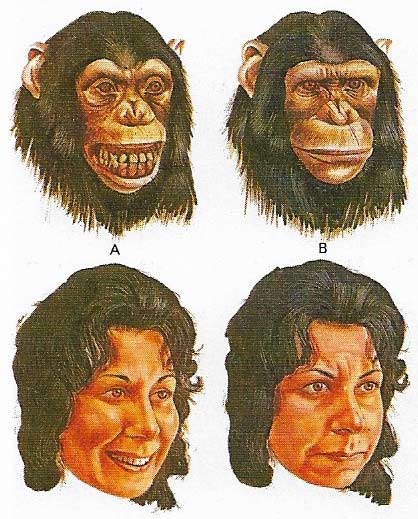
Figure 1. Facial expressions in both humans and apes show many similarities. The smile is usually a sign of happiness. But it is also one of the easiest expressions to "put on" and may be used to conceal real feelings of fear, anxiety or dislike. The tense grin adapted by a chimpanzee when approaching a more dominant male parallels the nervous smile a woman may wear in a stressful social situation (A). In both the expression is meant to demonstrate lack of hostility. When aggressive or angry (B) both primate and human display a stare and, at least initially, a firmly closed mouth.
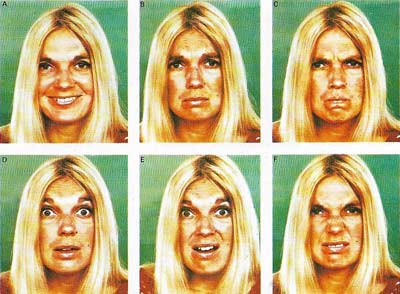
Figure 2. Facial expressions in both humans and apes show many similarities. The smile is usually a sign of happiness. But it is also one of the easiest expressions to "put on" and may be used to conceal real feelings of fear, anxiety or dislike. The tense grin adapted by a chimpanzee when approaching a more dominant male parallels the nervous smile a woman may wear in a stressful social situation (A). In both the expression is meant to demonstrate lack of hostility. When aggressive or angry (B) both primate and human display a stare and, at least initially, a firmly closed mouth.
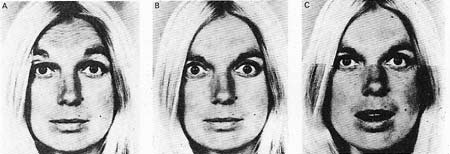
Figure 3. Partial expressions are more difficult to interpret than full-face displays of emotion. The human face is tremendously flexible and under considerable voluntary control. An emotion such as surprise may therefore appear in only one part of the face and then only for a very short time. The main areas in which such fleeting expressions of emotion may be detected are the brow (A), the eyes (B) and the mouth (C). To make it easier to separate the characteristic signs of surprise, each area is shown superimposed on a neutral face.

Figure 4. The extent to which people touch each other varies widely according to culture and relationship. A 1966 American study showed where male and female students were touched most often by parents and friends.
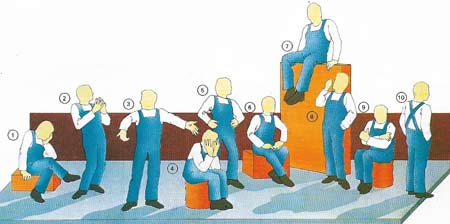
Figure 5. Posture and gesture make up a fundamental part of the repertoire of non-verbal communication. One look at a collection of people reveals much about their characters and moods. A man with head in hands and drooping eyes 1 is shut off from the group and does not hide his boredom or sadness. Another 2 show self-confidence or smugness by forming a steeple of his hands while the open hands of 3 suggest sincerity and warmth. Sorrow or shame or typified by the way that 4 hides his face. The erect posture with hands on hips of 5 conveys assertiveness. An attentive posture is taken by 6; he sits on the edge of his seat leaning forwards with hands on mid-thighs. The fact that 7 has chosen the highest place may show that he is the most dominant of the group or simply that he is aloof. Touching or rubbing my nose 8 is associated with doubt while the arm-gripping, defensive posture of 9 suggests that he is nervous (or perhaps sitting in a draught). A nervous person may wrap his fingers around his biceps so hard that the knuckles show white. Finally 10 shows lack of interest by turning away from the group entirely.
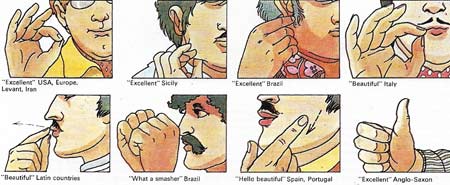
Figure 6. Gestures can convey a common emotion such as approval in many ways.
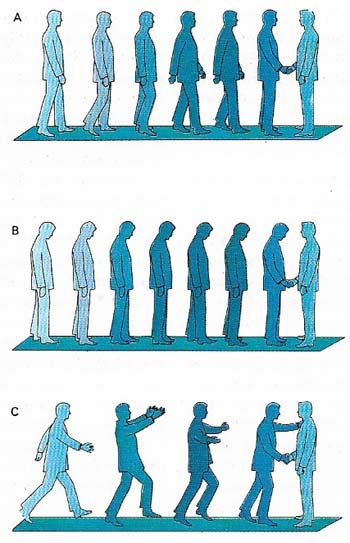
Figure 7. When people meet, their posture and movements can reveal a great deal about their emotional state. Normally, when a man walks across a room to shake hands, he holds himself erect, swings his arms and remains balanced and in control (A). If he is depressed, on the other hand, he tends to bend his head and shoulders forwards, taking small, shuffling steps and holding his arms by his sides (B). When a man is elated and excited his body may lose its natural balance and erectness, his arms swing widely and his gait becomes erratic (C). These movements are often seen when old friends meet. They can also be associated with a manic state of mind.
People communicate with each other in many ways other than by speaking or writing. Animals build quite complex societies by means of non-verbal communication and humans reveal a surprising amount about themselves by the use of gesture, posture, facial expression and other forms of behavior. Several thousand pieces of information can be exchanged within seconds of a meeting.
Ways of expressing emotion
In addition to outward facial and bodily signals, including the use of costume and adornment, there are less obvious means of communication – the use of time and space. Touching (Fig 4) and distance or nearness of approach can reveal much about a relationship. Punctuality can convey eagerness. On the other hand, a person who keeps someone else waiting can convey an impression of busyness that may be either genuine or false.
In evolutionary terms non-verbal communication preceded speech, and the existence of a system for expressing emotions was particularly significant to man's development. More than a century ago Charles Darwin (1809–1982) suggested that emotions help a species to survive and that feelings such as happiness, sadness, fear, anger, surprise, and disgust each have unique forms of display.
While the expression of these emotions looks similar in all humans (Figure 2), cultures differ in the degree to which emotional displays are encouraged or discouraged. In many Western societies, for example, men are not supposed to cry and women are discouraged from showing extreme anger.
Accurate reading of emotion from the face is complicated by man's ability to control his expressions by masking some feelings and fabricating the appearance of others (Figure 1). In addition, many facial displays last only a fraction of an instant. Displays may also be partial – occurring on only one area of the face (Figure 3) – or they may be a blend, combining two or more emotions in one expression. People differ in their ability to decode expressions, particularly fleeting ones.
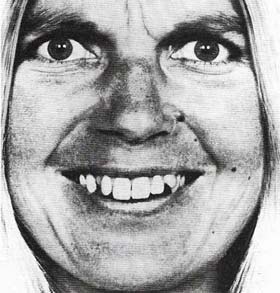 |
| A blend expression, in which more than one emotion is shown on the face at once, can often be seen as a person's response changes, producing startling effects such as an angry brow and a laughing mouth. |
Specific emotions are even more difficult to read from body posture. But overall attitudes, positive or negative, are easily recognizable (Figures 6 and 7). Interest or disinterest is shown by whether the body is erect or slouching, leaning backwards or forwards. Attraction or dislike is revealed by approach or avoidance. Status is indicated by the assumption of a higher or more dominant position in a group.
The significance of gestures
Gestures can be classified in a number of ways. Adaptors are movements that, at least originally, helped man to adapt to his environment. Scratching, wiping and fondling are examples. Regulators are movements that guide the flow of speech or contact between people; nods and eye signals are used, for example, to encourage a speaker to continue or to indicate a wish to interrupt. Conversation without regulator gestures (as when someone does not react at all to what is said to them) can be disconcerting. Illustrators are movements that help to elaborate, punctuate and clarify speech. Emblems have specific word-like meanings and often replace words and phrases.
Adaptors are often used unconsciously with no intention of communicating any-thing, although an observer may find them informative. A psychotherapist, for instance, may notice that a person fiddles with his hands when a troublesome topic is broached.
Regulators, too, are used with little awareness. In many cultures gestures of greeting serve as more conscious regulators. The appropriate bow, handshake, hug, or kiss must be delivered before conversation can take place.
Illustrators arc classified into sub-categories such as pointers, indicating which object is being discussed; spatials, indicating size or space relationships; batons, used for punctuation or emphasis; pictographs, outlining or portraying an object; ideographs, tracing the flow of an idea; and kinetographs, reenacting some bodily movement. In Germany, Nazi theorists once argued that illustrative gestures were innate – that, for example, Jewish people had distinctive, innate gestures. A pioneering work by David Efron in New York showed that gestures did differ between eastern European Jews and southern Italians. But it showed also that these gestures changed in second-generation immigrant groups. Thus illustrators are learned, just as language is also learned.
Emblems in communication
Emblems are usually employed consciously to communicate. Examples include the direction-indicating thumb of the hitchhiker and the two-finger "V" for victory (or peace) signal. The significance of emblems differs sharply from one language to another. The American "A–OK" gesture, with forefinger and thumb forming a circle, for instance, has vulgar, derogatory connotations in many parts of the world.
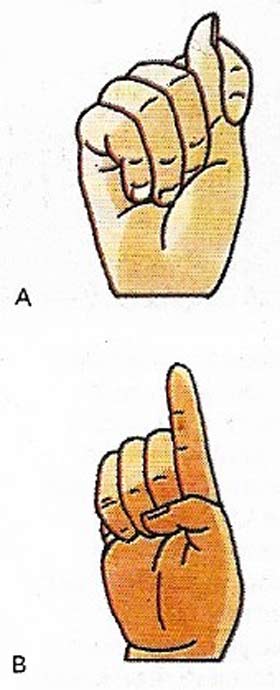 |
| An insult to one person may be a complement to another. Tucking a thumb beneath the forefinger (A) is a good luck charm in Brazil but a jeer or obscenity elsewhere. A raised forefinger (B), vulgar in Anglo-Saxon countries, means "Wait, I have an idea" in Italy, Austria in among Jews but "God is my witness" to gypsies. It may also be an auction bid. |
Advances in modern technology have made non-verbal messages become increasingly important, especially in visual media such as television and the cinema. There has been a corresponding increase in research into the ways in which these communication patterns have evolved and are used in different cultures today. The term kinesics has been applied to the study of body movement and efforts have been made to analyze it in the same way as linguists analyze language.


